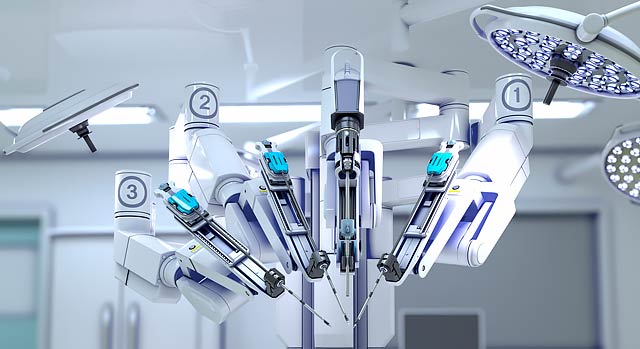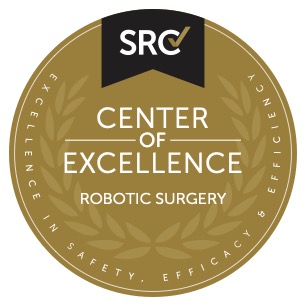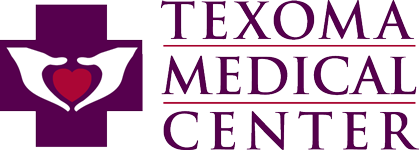Minimally Invasive, Robotic-assisted Surgery
Both robotic surgery and laparoscopic surgery are known as minimally invasive procedures. In both procedures, small incisions are used, which may result in less post-operative pain, reduced blood loss, less need for blood transfusions and a potentially faster recovery time.
 Texoma Medical Center was the first hospital in the region to provide robotic surgery. The hospital has two da Vinci® Xi® surgical units for general procedures, a Mako SmartRobotics™ unit for orthopedic procedures, and an Ion endoluminal system unit for lung biopsies.
Texoma Medical Center was the first hospital in the region to provide robotic surgery. The hospital has two da Vinci® Xi® surgical units for general procedures, a Mako SmartRobotics™ unit for orthopedic procedures, and an Ion endoluminal system unit for lung biopsies.
The two major drawbacks of conventional laparoscopy (without the use of robotic surgical system) are that it relies on the use of rigid, hand-held instruments, and visualization is provided by a standard 2D video monitor rather than a 3D field. While standard laparoscopic surgery is performed using small incisions, the surgeon's depth of field, dexterity and precision may be variable.
Center of Excellence in Robotic Surgery
 Texoma Medical Center achieved accreditation from Surgical Review Corporation (SRC) as a Center of Excellence in Robotic Surgery. This accreditation recognizes TMC’s commitment and high standard of delivery of quality patient care and safety.
Texoma Medical Center achieved accreditation from Surgical Review Corporation (SRC) as a Center of Excellence in Robotic Surgery. This accreditation recognizes TMC’s commitment and high standard of delivery of quality patient care and safety.
Potential Benefits Over Traditional Open Surgery
Potential benefits of robotic surgery over traditional open surgery include:
- Shorter hospital stay (one day in most cases versus three to five days)
- Significantly less pain post operatively (often only over-the-counter pain medications are required)
- Quicker recovery and return to normal activities (one to two weeks versus six to eight weeks)
- Fewer complications and less risk of infection
- Less scarring: Small, dime-sized incisions versus a six- to eight-inch scar.
Are you a good candidate for robotic surgery?
Not all procedures can be done robotically, and not all patients are candidates for procedures that can be performed robotically. The best candidates for robotic surgery are chosen on an individual basis by your doctor. Ask whether or not your diagnosis and situation will lend itself to robotic surgery.
Individual results may vary. There are risks associated with any surgical procedure. Talk with your doctor about these risks to find out if robotic surgery or minimally invasive surgery are right for you.
Get a referral
Call our free physician referral service at 903-416-3627 or search for a doctor online.
Types of Robotic Systems
da Vinci® Xi® Surgical System
Surgeons at the Center for Robotic Surgery at Texoma Medical Center use the da Vinci® Xi® Surgical System. This advanced robotic platform enables doctors to perform complex procedures using smaller incisions than standard surgery with tiny, precision tools operated robotically. This may result in less pain, scarring, trauma and blood loss than other surgical procedures so that patients can potentially return to work and daily activities more quickly.
TMC's program is also the first to offer Single-Site® surgery for hysterectomy and gallbladder removal. Surgeons at the TMC Center for Robotic Surgery use the da Vinci Surgical System to perform the following procedures:
The da Vinci Surgical System consists of a surgeon's console, a patient-side cart with four interactive robotic arms, a high-performance 3D, high-definition vision system and the system's EndoWrist® instruments. Using advanced robotic technology, the da Vinci System is designed to translate a surgeon's hand movements into precise movements of the EndoWrist instruments.
Mako SmartRobotics™
Mako SmartRobotics™ provides relief for joint pain through the use of minimally invasive robotic surgery. Pain from arthritis and joint degeneration can be constant, come and go, occur with movement or after a period of rest or located in one or many spots of the body. There are many different treatment options available, so talk to your medical provider about if Mako SmartRobotics™ could be the right treatment for you.
Types of surgery that use Mako SmartRobotics™
- Total knee
- Partial knee
- Total hip
This minimally invasive surgery is provided by orthopedic surgeons who have undergone full-training on the device.
Ion Endoluminal System from Intuitive
Using the Ion endoluminal system from Intuitive, surgeons at Texoma Medical Center in Denison, TX, perform robotic-assisted bronchoscopies for patients who have suspicious lung nodules.
